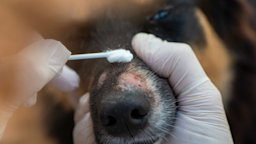Key takeaways:
Fungal infections in dogs can cause many symptoms, including itchy skin, skin sores, hair loss, fever, and cough.
If your dog gets a fungal infection, it can affect their skin or organs if it spreads.
Since many different fungi can cause infections, your veterinarian will need to determine your dog’s specific type of fungal infection to decide how to best treat them.
You might think nothing of your dog’s itchy paws or the small sore that’s formed on their leg, but these seemingly minor issues can be signs of a fungal infection.
Fungi are parasitic organisms that produce spores and absorb food from hosts, such as your dog. Many types of fungi exist, but it’s most common for dogs to become infected by fungi that live in the soil. Your dog might inhale or ingest this fungi, or the fungi might get into their body through a cut or wound.
Fungal infections can be irritating and uncomfortable for dogs, but they can also affect their organs. When you’re familiar with the common signs of fungal infections in dogs, you can quickly recognize the problem and get your dog to the veterinarian for the treatment they need.
Search and compare options
Signs of a fungal infection in dogs
Fungal infections can cause many symptoms in dogs. Here are 13 of the most common:
Skin sores
Itchy skin
Skin lesions that drain
Limp and swollen joints
Nasal discharge
Blood in urine
Poor body condition
Weight loss
The symptoms that your dog experiences will depend on the type of infection and whether the infection is limited to their skin, or local, versus a systemic infection.
According to Jamie Whittenburg, DVM, chief of staff at Kingsgate Animal Hospital in Lubbock, Texas, when fungal infections are limited to the skin, they most often affect certain areas. These include the external ear canals, area around the toenails, groin and armpits. But systemic infections can spread throughout a dog’s body, she told GoodRx Health, affecting major organs such as the lungs and liver. These infections can be life-threatening.
Symptoms including skin sores, nasal discharge, and itchy skin may indicate a local infection. If the infection is systemic, you may see other, more widespread symptoms, such as blood in your dog's urine.
Types of fungal infections in dogs
There are several common types of fungal infections in dogs. Each type of infection is caused by a different type of fungus, and the infections cause different symptoms.
Is your dog itchy? Fleas aren’t the only cause of itchy skin in dogs. One of these common reasons could be to blame.
Is your dog’s food making them sick? Here’s how to spot food allergies and what to do about them.
Is the lepto vaccine necessary? Yes. Read why the vaccine that protects against leptospirosis disease is essential for dogs.
Histoplasmosis
A fungus called Histoplasma causes histoplasmosis. This fungus is often found in soil that has a high nitrogen content, such as soil that’s been contaminated with bird or bat droppings.
Your dog can inhale the fungal spores, and those spores become a yeast once they’re in your dog’s lungs. Histoplasmosis can be localized to your dog’s lungs, or it can travel through their blood and affect other organs.
Blastomycosis
A fungus called Blastomyces lives in moist soil and decomposing wood and leaves. This fungus causes an infection called blastomycosis. Blastomyces is primarily found in:
Great Lakes region
Mississippi River valleys
Ohio
Read more like this
Explore these related articles, suggested for readers like you.
A blastomycosis infection occurs when a dog inhales the fungus spores and they transform into yeast in the lungs. The infection can stay within the lungs, or it can travel through the bloodstream and affect other organs.
Coccidioidomycosis
Coccidioidomycosis, also called Valley fever, is caused by the fungus Coccidioides, which is found in soil in warm, arid climates. This fungus is primarily found in:
Arizona
California
Nevada
New Mexico
Oregon
Texas
Utah
Washington
If the soil is disturbed by an event such as a dust storm or construction, your dog may inhale the spores in the soil. Once in your dog's body, the spores transform into yeast and cause a fungal infection.
Ringworm
Ringworm is caused by several different fungi, including:
Microsporum canis
Microsporum gypseum
Trichophyton mentagrophytes
These fungi spread easily. And your dog can become infected through contact with objects, such as furniture or grooming tools, that contain the spores.
Ringworm infections most often affect the face, ear tips, tail, and feet. It’s common for infected dogs to develop scaly patches and experience hair breakage or loss.
Fungal dermatitis (yeast infection)
Malassezia dermatitis is a common fungal yeast infection in dogs. Malassezia are organisms that live naturally on the surface of the skin. Fungal dermatitis occurs when there’s an overgrowth of these organisms.
Several conditions on a dog’s skin can cause the organisms to overgrow, such as:
Increase in skin oils during an allergy flare-up
Immune deficiency
Excess oil production (seborrhea)
Is my dog’s fungal infection contagious?
Whittenburg said some fungal infections in dogs are contagious to other pets and humans, but others are not.
“Malassezia spp. are fungal organisms that are normally present on the skin but can overgrow and cause a skin infection. These infections are not contagious,” she said. “On the other hand, ringworm (most often Microsporum canis) is contagious between dogs, cats, humans, and other animals.”
If you suspect your dog has a fungal infection, it’s best to assume the infection is contagious until your veterinarian diagnoses the specific type.
To prevent the spread of a fungal infection:
Keep your dog away from other pets in your home.
Limit how much you and other people are in contact with your dog.
Wear long sleeves and gloves when you do handle your dog.
Schedule an appointment with your veterinarian right away, so you can confirm whether your dog’s fungal infection is contagious.
Treatment options for fungal infections in dogs
Before treating your dog, your veterinarian will diagnose the specific type of fungus causing the infection. Then, your vet will tailor a fungal infection treatment for your dog and their condition, Whittenburg said. This could include medicated shampoo or topical ointment.
Your vet may also prescribe an oral antifungal medication, such as:
In addition, your veterinarian will want to address any underlying condition that is causing the fungal skin infection, such as allergies, Whittenburg said.
What happens if a fungal infection is left untreated in dogs?
“Left untreated, fungal skin infections in dogs can lead to severe itching and discomfort, self-mutilation injuries, secondary bacterial infections, and other complications,” Whittenburg said.
In addition, she said, “In the case of ringworm, the untreated pet will contaminate the environment and spread the condition to others.”
Systemic fungal infections can progress to serious and even life-threatening symptoms. For example, blastomycosis can cause difficulty urinating, bloody nasal discharge, and ultimately an infection in your dog’s brain.
Getting your dog prompt treatment can keep them more comfortable. And hopefully your veterinarian can start treating the fungal infection before it has progressed and caused these more severe symptoms.
Frequently asked questions
Ask your veterinarian if there are any home remedies that can help your dog. In most cases, your dog will likely need a more traditional treatment, such as medication.
Some evidence suggests that vinegar rinses may be an effective home remedy against dog fungal infections. But they don’t work for dogs in all cases, and they still need to be applied under the supervision of a veterinarian. Your vet can tell you how much water to use to dilute the vinegar.
No. Only use antifungal creams on your dog that are prescribed by a veterinarian and made specifically for pets. Then follow your vet’s instructions carefully. Only use a human antifungal cream on your dog if your vet prescribes it.
Bacterial and fungal infections in dogs have similar symptoms, making it hard to tell them apart. It’s best to take your dog to a veterinarian, who can run tests and diagnose the infection properly. Testing is the best way to know for sure which infection your dog has.
Ask your veterinarian if there are any home remedies that can help your dog. In most cases, your dog will likely need a more traditional treatment, such as medication.
Some evidence suggests that vinegar rinses may be an effective home remedy against dog fungal infections. But they don’t work for dogs in all cases, and they still need to be applied under the supervision of a veterinarian. Your vet can tell you how much water to use to dilute the vinegar.
No. Only use antifungal creams on your dog that are prescribed by a veterinarian and made specifically for pets. Then follow your vet’s instructions carefully. Only use a human antifungal cream on your dog if your vet prescribes it.
Bacterial and fungal infections in dogs have similar symptoms, making it hard to tell them apart. It’s best to take your dog to a veterinarian, who can run tests and diagnose the infection properly. Testing is the best way to know for sure which infection your dog has.
The bottom line
While fungal infections in dogs can be irritating and uncomfortable when they affect the skin, these types of infections can also become systemic and cause some very serious symptoms.
Since many fungi live in the soil, it can be difficult to prevent fungal infections. But when you’re familiar with the common symptoms of fungal infections in dogs, you can quickly recognize if your pup is having an issue. If you suspect that your dog has a fungal infection, make sure to get them prompt veterinary care.

Why trust our experts?



References
Brister, J. (2021). Histoplasmosis in dogs and cats. Veterinary Partner.
Brooks, W. (2024). Malassezia dermatitis (yeast infection of dog's skin). Veterinary Partner.
California Department of Public Health. (2022). Ringworm and pets.
Gull, T. (2024). Blastomycosis in animals. Merck Veterinary Manual.
Gull, T. (2024). Coccidioidomycosis in animals. Merck Veterinary Manual.
Lundgren, B. (2019). Blastomycosis is a systemic fungal infection affecting dogs
and cats. Veterinary Partner.
Marsella, R. (2024). Investigation into the effects of allergen exposure and topical vinegar and water spray on skin barrier parameters in atopic dogs. Veterinary Sciences.
Merchant, S. R. (2024). Ringworm (dermatophytosis) in dogs. Merck Veterinary Manual.
MiraVista. (n.d.). Fungal diseases.
Morrison, M. (n.d.). Fungal disease. University of Missouri Veterinary Health Center.
Pascutti, K., et al. (2021). Approaches to opportunistic fungal infections in small animals. Today’s Veterinary Practice.
Rhimi, W., et al. (2020). Malassezia spp. yeasts of emerging concern in fungemia. Frontiers in Cellular and Infection Microbiology.
Shipstone, M. (2024). Antifungals for integumentary disease in animals. Merck Veterinary Manual.
Taboada, J. (2024). Fungal infections in dogs. Merck Veterinary Manual.

















